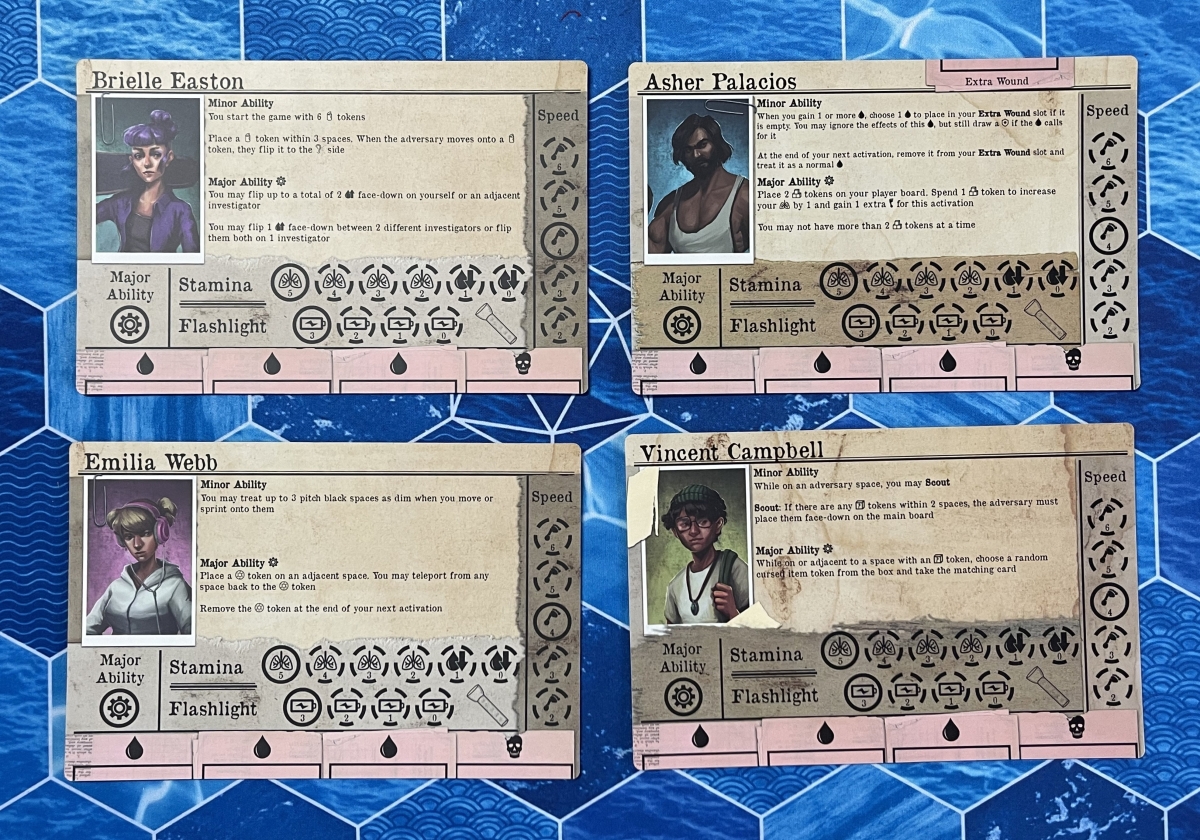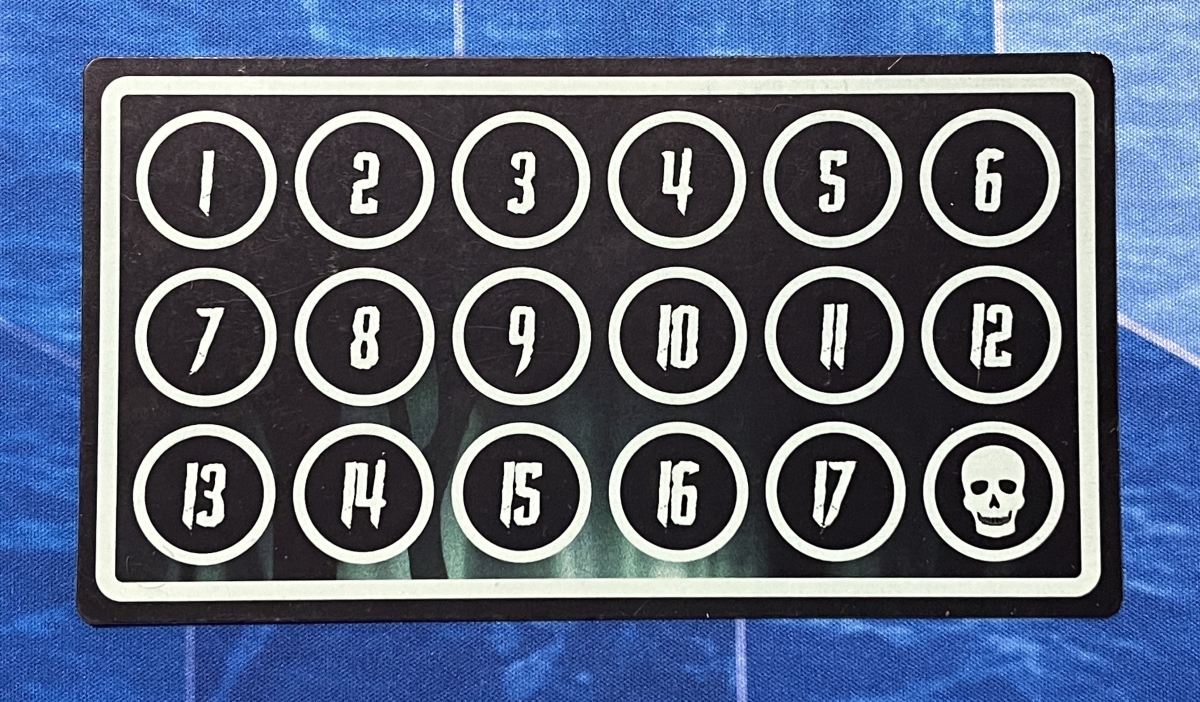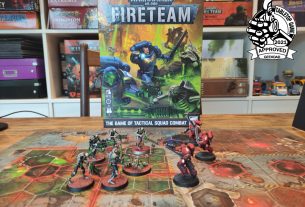Local rumor has it that a shadowy figure appears every 10 years to satiate its hunger for bloody justice. As soon as its victim is claimed, it returns to dormancy and another decade passes. Ten years is just
long enough for people to chalk up the horror as folk-lore while that dark form awakens, starting the cycle over again.
The investigators came to this abandoned sawmill based on local legends that suggest there may be paranormal activity here. Their goal is to collect enough evidence to prove the rumors are true and either escape or put a stop to it.
What Is The Stifling Dark?
The Stifling Dark is a one-versus-many, hidden movement game for 2-5 players, ages 14 and up, and takes about 25 minutes to play per player. It’s currently seeking funding on Kickstarter, with a pledge level of $50 for a copy of the game, or $70 for the game, Nightfall expansion, and card sleeves.
The Stifling Dark was designed by Jeremy Geenen, Ethan Janssen, and Matt Rayford, and published by Sophisticated Cerberus Games, with illustrations by Cory Freeman.
New to Kickstarter? Check out our crowdfunding primer.

The Stifling Dark Components
Note: My review is based on a prototype copy, so it is subject to change and may not reflect final component quality though many of the components have been finalized.
The base game contains the following:
- Game Board
- Adversary Mini Game Board
- 9 Player Standees
- 9 Player Boards
- 9 Player Aids
- 4 Dice
- 105 Mini Cards
- 95 Full-Size Cards
- 214 Tokens
- 2 Straightedges
- First Player Marker
- Round Tracker
- Player Screen
As you’ve probably noticed from the picture above, there’s both a full-sized game board and a quarter-sized version of the same. As this is a hidden movement game, the smaller board is for the Adversary player to use to chart their movement.

One of the players in my game group was disappointed with the look of the board, but he had never before played a hidden movement game. There were two factors that he failed to take into account: that the game takes place in dim or dark spaces, hence the overall darkness of the board, and the importance of having clearly identifiable spaces on the board for gameplay. In my opinion, the game board is quite easy to read and serviceable for a hidden movement game.

There are a lot of different tokens in this game, most of them small enough to fit perfectly onto the spaces on the game board and player sheets. The tokens were a little hard to punch out without tearing some of the paper, but this is a prototype-only situation and will be fixed in the production version of the game.

The plastic flashlights are the signature component in The Stifling Dark. They are used to reveal hidden items, clues, and the Adversary. Though the flashlight appears green in the picture above, that’s due to my blue playmat. The plastic is actually a translucent yellow.

The game comes with two standard six-sided dice, as well as two custom dice used when characters are sprinting. The number of feet on the dice indicate the number of spaces a character can move in addition to their base movement speed.

The player boards are made of thick card, and have spaces to track such stats as speed, stamina, and flashlight charge. There are slots at the bottom of each player board for wound cards. Receiving a fourth wound card results in the death of the Investigator.
Each of the Investigators have different abilities, which are detailed on the cards. Minor Abilities may be used repeatedly, while the Major Ability may only be used when in possession of a Major Ability token. On the back of each player board is some background fluff about the character, as well as their play style.

There are many different types of cards in the game. Item tokens are randomly seeded onto the game board during setup. When acquired, the player will then draw the matching card from the deck. Some of the items have multiple uses, and some can only be used once.

Throughout the game, Investigators can receive wounds or conditions. Conditions are mostly minor hindrances, but wounds can result in the death of an Investigator. Additionally, when an Investigator receives a face-up wound, they will receive additional penalties as written on the card.

There are up to 17 rounds to the game. Should neither side win by the end of that point, then… well, the current draft of the rules don’t say exactly what happens other than the investigators have 17 rounds to complete their goals. However, that skull next to the 17th round marker has some ominous implications.
How to Play The Stifling Dark
You can download a copy of the rulebook here. You can also try out the game for free on Tabletop Simulator.
Note: While the final game will contain multiple scenarios and Adversaries, the prototype only contains one of each: “The Sawmill” and “The Butcher.”
The Goal
The goal of the game is different depending on whether you’re playing an Investigator or The Adversary. Investigators find and collect evidence hidden on the map to either unlock an escape route or eliminate the Adversary. The Adversary’s objective will depend on the particular one being played, but generally involves hunting down the Investigators. The Butcher’s objective is to kill one of the investigators.

Setup
Begin by choosing a scenario and gathering the corresponding items. Place the event deck for the scenario at the top of the board, and evidence deck and objective item deck at the bottom of the board.
The player playing the Adversary chooses which Adversary to play, then sets up the mini-map, Adversary player board, and related cards/tokens behind the player screen. They then shuffle 9 random general item tokens and 1 random cursed item token, and place them each within 2 spaces of an adversary space (as indicated by a red skull) on their mini-map. Evidence tokens are then placed according to the specific scenario.

Place the round tracker next to the board, with the round tracker token on the “1” space. Item and cursed item decks should be placed face-down next to the board. Wound and mitigation decks are shuffled, and placed alongside the condition deck face-down next to the board. Dice and player aids are placed within easy reach of the players.
Each player selects an investigator and places the appropriate player board in front of them. Speed, stamina, and charge tokens are placed on board on their starting spaces, and a major ability token is placed on the open slot. Each player also takes a flashlight. Finally, each player takes their matching figure, and places it on one of the starting spaces, as denoted by a dashed green circle.

Gameplay
Each round, all of the Investigators will take their turns, followed by the Adversary. Here is the round order:
Start Phase
Draw an Event Card (depending on the scenario) and follow the card instructions.
Investigator players then choose the order in which they’ll activate.

Investigator Activation
On their turn, an Investigator can take any number of actions. These include:
- Move: move a number of spaces up to their current speed. Moving in and out of pitch black spaces costs an extra movement per space.
- Sprint: reduce their stamina by 1, then roll the sprint die, and add the number of spaces shown to available movement. If reducing the stamina lands the stamina token on a wound icon, they immediately get one face-down wound card.
- Interact: Pick up or drop items, close or open doors, use an item or evidence card, trade with an adjacent investigator, interact with an interaction space. Some interactions are Involved Actions, which end the Investigator’s turn and prevent them from using their flashlight or increasing stamina or flashlight charge.
- Use ability: Use a Major or Minor ability.
Once they’ve taken as many actions as they want or can, the Investigator may place their flashlight. They lower their charge token by 1, and then place the flashlight around the base of their figure, swiveling it until it covers the area that they want to light up. If there are evidence tokens, item tokens, or the Adversary figure on a space that’s fully under the flashlight and line of sight is not blocked by objects, then the Adversary moves the tokens from the mini-board to the game board.

At the end of any Investigator’s turn, they first check for resolved mitigations. Mitigations are cards that attach to some face-up wounds. You have the option of fulfilling the requirements of a mitigation in order to turn that wound face-down. While it doesn’t remove a wound, it does remove the penalty that the face-up wound gives the Investigator.

Then, the Investigator increases their stamina by 1 if they didn’t sprint on that turn, and/or increase their charge by 1 if they didn’t use their flashlight.
Investigator End Phase
Any noise tokens on the board are removed, as well as any appropriate Adversary tokens.
Adversary Activation
The Adversary can use any number of the following actions:
- Move. Can move a number of spaces equal to their move speed, plus a sprint die roll. Movement is not affected by pitch black spaces, and is done in secret on the mini-map.
- Use Cards: Each Adversary has one attack card and a number of ability cards available to them. They may resolve each of them once, as long as each card’s trigger conditions are met.


Additionally, the Adversary can use any actions listed on their player board, if they meet the conditions.

End Phase
After the Adversary has gone, the following steps are taken:
- Adversary cleans up.
- Check for resolved mitigations.
- Remove flashlights from the board.
- Advance the round tracker.
Game End
The game ends when either the Adversary or the Investigators have fulfilled their respective objectives.
Why You Should Play The Stifling Dark
I’m a fan of hidden movement games. I’ve enjoyed many a session of Letters From Whitechapel, Jaws, and Fury of Dracula. I also love horror-themed board games, so I jumped at the chance to check out The Stifling Dark.
The premise of the game feels like it came right out of a horror film: a group of investigators ends up with more than they bargained for when they look into reported paranormal activity. Horror is a great fit with the hidden movement mechanic. The three games I mentioned have Jack the Ripper, the shark from Jaws, and Dracula himself as the games’ respective foes. The Stifling Dark fits right in with this crowd.
The use of the flashlight as a player mechanic for searching for needed items and evidence, or for the Adversary themselves, is a welcome addition to the genre. Besides thematically fitting with the horror theme, it actually ups the tension at the game table as players try to locate the Adversary and avoid their attacks. Using the flashlight is simplicity itself, though players must be cognizant of the many obstacles on the board that can block line of sight.
I liked the mitigation cards in theory, but in practice we found that those cards added an additional layer of complexity to the game that was more often than not ignored by my game group. Usually, taking the steps to complete the mitigation were time consuming and distracting from the players’ goals. With so many cards already on the table, I felt like got in the way of the gameplay rather than adding to it.
While 17 rounds of gameplay seems excessive, in practice most games will end well before this. One of my games ended during round 8, with The Butcher attacking a wounded Investigator through a window and ending their life.
That actually leads to another of my criticisms. We all felt that The Butcher seemed a bit overpowered in their abilities. While they can’t attack when the light shines upon them (they can only escape at that point), The Butcher’s damage output when he is hidden is quite potent. The “rend” ability gives an Investigator 2 wounds, and almost all of the Investigators can take only 4 wounds before they die. There are also very few ways to actually remove wounds from Investigators. It would be nice to see The Butcher toned down a bit, and perhaps some healing items added to the game. One of my friends suggested a searchable med kit in one of the buildings.
The Kickstarter campaign will be adding more Adversaries, but I have no idea how much damage they will do, or what their win conditions will be. Hopefully they’ll have some interesting differences, and they’re likely to be discussed when they’re revealed as stretch goals are met. The campaign is looking to introduce new items and mechanics as well, such as an augmentable flashlight in the Nightfall expansion.
Overall we all enjoyed playing the highly-thematic The Stifling Dark, despite our few criticisms. It’s a surprisingly easy game to learn to play, and really captures that horror movie feeling of being stalked by a killer in the dark. I’m looking forward to seeing the Adversaries and additional scenarios that the campaign will be adding to the game.
For more information or to make a pledge, visit The Stifling Dark Kickstarter page!
Click here to see all our tabletop game reviews.
![]() To subscribe to GeekDad’s tabletop gaming coverage, please copy this link and add it to your RSS reader.
To subscribe to GeekDad’s tabletop gaming coverage, please copy this link and add it to your RSS reader.
Disclosure: GeekDad received a copy of this game for review purposes.





